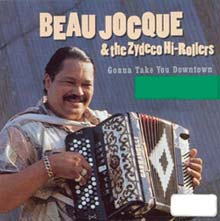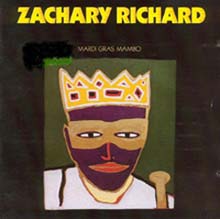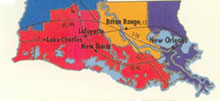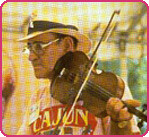Acadia, a peninsula of Canada, where, for more than a century, the French people of Canada lived. A farming people, they didn’t suffer from the fights between English and French [armies] for control of the area. Then came the " Grand Dérangement" : from 1755 onwards victorious England decided to deport all French speakers from Acadia. The community was dispersed within English colonies, notable the West Indies. Some of them arrived in France and settled in Belle-Ile-en-mer (Brittany). Most died because of this deportation. Some of the survivors decided then to gather together in Louisiana where there was a small French colony that had been established in the time of Louis XVI. The Acadians ended up in some of the most inhospitable areas : the bayous, marshes inhabited by alligators. Despised and poor, they lived withdrawn into themselves, but yet in the space of a generation had recreated a strong community. The " Cadiens " or " Cadjins " then began mixing with and assimilating other ethnic groups: French-speaking Creoles, Europeans, Haitians, and Anglo-Americans. Even though forbidden at school, French remains the most widely spoken language.
Today, the Cajun region or Acadania is made up of 22 parishes (equivalent to counties) of South Louisiana state and is home to the biggest French-speaking minority in the USA. Lafayette is the capital of this French-speaking community. Following the politician Dudley Le Blanc’s first demands in 1955, it was only in1968 that the State officially recognized the Cajuns, founding the CODOFIL (Lousiana French Development Council). Cajun culture is now recognized and famous for its music, gastronomy, and " Laisser les bons temps rouler ".(let the good times roll...) philosophy. In 1999, the 700 000 descendants of the French-speaking communities organised the second Acadian world congress, one of the objectives of which is to bring together scattered families. As descendants of farmers from the south and west of France, they are proud at having been able to safeguard their culture, which they hand on to their children.
Cajun music
Acadian music, French music or Cajun music, gives rhythm to the daily life of Acadian people who express its joie de vivre through dances, ceremonies, parties as well as the festivals that sprang up in the 70’s.
Their music blends the tones of French violin, Spanish guitar, ("tity fer" or "ting-a-ling") triangle, and German accordion. The tunes recall those of the bourrées (country dances). The songs speak of daily life, their exodus from Acadia, their disappointed loves, the beauty of nature... This music survived thanks to lullabies, traditional songs, religious hymns, and most of all the "balls".
The traditional cajun ball is called the " fais do-do " in reference to the mothers who stamped their feet with impatience on the edge of the dance floor waiting for their children to get to sleep. In Eunice, the famous Rendez-vous des Cajuns is held every Saturday night at the Liberty Theater.
Some famous Cajun artists are: Joseph FALCON, BEAUSOLEIL, LES FRERES BALFA, Steve RILEY, Zachary RICHARD (a young accordionist born in Lafayette in 1950) who started with his band LE BAYOU DES MYSTERES.
Where to dance:
BLUE MOON 215 E. Covent st, Lafayette (TEL 337 234 2422)
LA POUSSIERE 1215 Grand Point Road, Pont Breaux/Breaux-Bridge (TEL 337 332 1721)
WHISKEY RIVER Henderson (TEL 337 228 8567)
Zydeco
 Two big varieties of Cajun music have developed: Zydeco (or Zideco) and Swamp Boogie - Rock’n’Roll sung with the Cajun accent.
Zydeco, created by the Creoles in the early 1950s, uses the instrumental basis of Cajun traditional music, but with Rhythm’n Blues accents. Also sung in French, the name of this musical style comes from an old song about unsalted beans, the "haricots" (beans) have been changed for "zideco". This music uses the "frottoir", an undulating steel rack on which the musicians beat time with spoons. More recently, other styles have appeared like zydeco-rap, zydeco-reggae, zydeco-rock,etc.
Two big varieties of Cajun music have developed: Zydeco (or Zideco) and Swamp Boogie - Rock’n’Roll sung with the Cajun accent.
Zydeco, created by the Creoles in the early 1950s, uses the instrumental basis of Cajun traditional music, but with Rhythm’n Blues accents. Also sung in French, the name of this musical style comes from an old song about unsalted beans, the "haricots" (beans) have been changed for "zideco". This music uses the "frottoir", an undulating steel rack on which the musicians beat time with spoons. More recently, other styles have appeared like zydeco-rap, zydeco-reggae, zydeco-rock,etc.
Some Zydeco artists are: Chris ARDOIN, BEAU JOCQUE, Boozoo CHAVIS, Clifton CHENIER " the King of zydeco ", Geno DELAFOSE, Keith FRANCK, Nathan AND THE ZYDECO CHA-CHAS, Walter MOUTON, Wayne TOUPS.
Where to dance: EL SIDO’S 1523 N Saint Antoine st, Lafayette (TEL 337 237 1959)
Mardi gras
 It’s celebrated all around Louisiana, but mainly in New Orleans and Lafayette. The festivities start officially from the Epiphany, the krewes (bands participating in the festivities, which presence is hereditary) organise some balls until the Pancake Tuesday. For a week, parades followed "fais do-do" / parades and "fais do-do" followed one another. Named every year, the Roi Gabriel and the Reine Evangelina are the guests of honour at the festivities.
Some parishes (Anse Maigre, Mamou, Basile, Savoy, Oberlin et Church Point) are celebrating the Mardi Gras in an original way. The Sunday preceding the party, the men of the village go on horseback all over the countryside, dressed up, the head masked by a hood. They enter each farm asking in French :" Voulez-vous suivre les Mardis gras ? " (do you want to follow the Mardi Gras people ?) Then they get off the horse and entertain their hosts for victuals. At the end of the day, a ball gathers all those taking part in...
It’s celebrated all around Louisiana, but mainly in New Orleans and Lafayette. The festivities start officially from the Epiphany, the krewes (bands participating in the festivities, which presence is hereditary) organise some balls until the Pancake Tuesday. For a week, parades followed "fais do-do" / parades and "fais do-do" followed one another. Named every year, the Roi Gabriel and the Reine Evangelina are the guests of honour at the festivities.
Some parishes (Anse Maigre, Mamou, Basile, Savoy, Oberlin et Church Point) are celebrating the Mardi Gras in an original way. The Sunday preceding the party, the men of the village go on horseback all over the countryside, dressed up, the head masked by a hood. They enter each farm asking in French :" Voulez-vous suivre les Mardis gras ? " (do you want to follow the Mardi Gras people ?) Then they get off the horse and entertain their hosts for victuals. At the end of the day, a ball gathers all those taking part in...
Gastronomy
About cooking, the Cajuns have a slogan : " On peut manger tout ce qui ne nous mangera pas le premier " (we can eat everything that won’t eat us first ". Their culinary tradition is actually a synthesis of French, Spanish and West Indies gastronomic traditions adapted to bayous basic products : rice, shellfishes, fishes, and seafood (shrimps).
The Po-boy, most known speciality, is a sort of local sandwich which may contain some fish, crawfishes, meat, oysters.
The jambalaya is prepared from a huge quantity of rice from which we add some ham, chicken, sausages, fresh pork, crawfishes and crab.
The gumbo is a soup made from tropical plant with rice, crawfishes, crab and spices. In winter, the andouille (sausage made with chitterlings) and chicken often take place of crabs and crawfishes.
Lafayette
 It’s the " capital " of the French-speaking Louisiana. This town of 100 000 inhabitants keeps a provincial charm. Towards North and West spreads out the Cajun prairie : land of ranches and ricefields. To the South is located the marshes region.
It’s the " capital " of the French-speaking Louisiana. This town of 100 000 inhabitants keeps a provincial charm. Towards North and West spreads out the Cajun prairie : land of ranches and ricefields. To the South is located the marshes region.
Worth seeing : the Lafayette Museum, the Saint-Jean l’Evangéliste cathedral, the Acadian village (South West of the town),...and the small provincial town of Abbeville.
Tourist Office : 1400 NW Evangeline Thruway (TEL 1 800 346 1958 or 318 232 3808).
Saint-Martinville
Named for a long time the " Petit Paris", this small town of 8000 inhabitants is well representative of the French speaking spirit. A big place made of French style; shops with evocative names : Broussard, Bienvenu or La Houssaye. Evangeline’s tale is linked to the town. Its tells the history of two young Acadians, Louis Arcenaux and Emmeline Labiche, which had been engaged just before the " Grand Dérangement ". Deported, Evangeline find herself back in Saint-Martinville, where she expects everyday the arrival of her fiancé. One day he lands but, meanwhile, he got married. Evangeline die of it.
Worth seeing : the Petit Paris museum, the Saint-Martin-de-Tours church (with its Lourdes’ cave copy), le chêne d’Evangéline (Evangeline’s oak), la demeure Duchamps (Duchamps’ home).
Tourist Office : La Remise, 127 New Market Street, PO Box 379 (TEL 1 504 394 2233 / FAX 504 394 7982)
Bâton Rouge
Le Moyne d’Iberville, sailor of Norman origins, explores the Mississippi in 1699 and spotted a tree coated with blood that Indians used for the sacrifices of wild animals and to delimit their hunting territories. Some French people settled in and found the current capital of Louisiana. This industrial town of 220 000 inhabitants got rich thanks to oil.
Worth seeing : the River City Blues and Bayou Festival (early September) and the French Quarter Festival (early April).
Tourist Office : Le Baton Rouge Area Convention, 730 North Boulevard (TEL 1 800 527 6843 ou 504 383 1825).
New Orleans
Founded by French people in 1718, the town became US territory from 1812. Few people speak French there, but the Vieux Carré and its French market are worth to be seen. The streets get some evocative names : La Salle, Dauphine, Toulouse, Carondelet, Marais,etc.
Tourist Office : 529 St Ann Street (TEL 1 504 566 5031).
Celebrations and festivals
January : celebration in Chalmette for the battle of New-Orleans.
February : Mardi Gras (Pancake Tuesday) celebrated all over Louisiana
March : " Bayous marécageux " Festival in Pine Prairie . French Quarter Festival à La Nouvelle-Orléans.
April : International Louisiana Festival in Lafayette.
May : " l’écrevisse " (crawfish) Festival in Breaux Bridge. Contreband Day in Lake Charles to celebrate the pirate Jean Lafitte’s landing. "l’héritage" Festival in the Saint Landry parish.
June : Acadian music Festival in Mamou.
July : Bastille Day the 14th of July in Kaplan to celebrate the French heritage and its gastronomic culture. Cajun Day in Jennings.
August : Shrimp Festival in Delcambre au bord du bayou Carlin (boats blessing).
September : Cajun and zydeco music Festival in Lafayette. Frog Party in Rayne (" ouaouarons " races and frog legs sampling). South West Louisiana zydeco Festival in Plaisance. Duck Festival in Gueydan.
October : Festival "Lagniappe on the bayou" in Chauvin (fishermen, trappers and beer lovers reunion). Cotton Festival, some Middle Ages knights confront each other in tournament in Ville Platte. Inheritage Festival in Lafayette. Louisiana Folklore Festival in Eunice.
November : French market Festival in Abbeville.
December : Cajun’s Christmas.
INFORMATION :
Codofil: 217 W Main Street
TEL 1 800 259 5810 or 318 262 5810
www.codofil.org
BOOKS:
"Cajun country" by Barry Jean Ancelet (UP of Mississippi, 1991)
"The Cajuns: americanisation of a people" by Shane K. Bernard (University Press of Mississippi, 2003)
Cajun and creole poetry:
Jean ARCENEAUX Suite du loup (Éditions Perce-Neige)
Antoine BOURQUE Trois saisons (Éditions de la Nouvelle Acadie)
David CHERAMIE Lait à mère (Éditions d’Acadie)
Debbie CLIFTON A cette heure, la louve (Éditions d’Acadie)
Carol DOUCET La charrue (Éditions de la Nouvelle Acadie)
Richard GUIDRY C’est p’us pareil (Éditions de la Nouvelle Acadie)
Zachary RICHARD Faire récolte (Éditions Perce-Neige)
Feux Follets XI (avril 2006), revue de création littéraire louisianaise (Éditions de la Nouvelle Acadie)
About Cajun literature: Dr. Olivier Marteau "Une littérature minoritaire francophone dans le sud de la Louisiane : Le pari de la création d’un champ littéraire (1980-2006)" (University of Louisiana at Lafayette, April 2007, 325 p.)
DVDs:
"GumbOh La la!" (13 episodes of 26mn)
"Coeurs Batailleurs" (26 episodes of 26mn)
Contact: www.louisianealacarte.org
CDs:
Alphonse "BOIS SEC" ARDOIN & Canray FONTENOT La musique créole (Arhoolie, 1966)
BEAUSOLEIL The best of (Arhoolie, 1981)
Clifton CHENIER The best of (Arhoolie, 2003)
Geno DELAFOSE La chanson perdue (Rounder, 1998)
Joseph FALCON Allons à Lafayette (1928)
FEUFOLLET Belle Louisiane (2001)
FRERES BALFA J’ai vu le loup, le renard et la belette (Rounder, 1976)
LOST BAYOU RAMBLERS Bayou perdu (Swallow, 2005)
PINE LEAF BOYS La musique (Arhoolie, 2005)
Zachary RICHARD Cap enragé (Initial, 1996)
Steve RILEY Bon rêve (Rounder, 2003)


